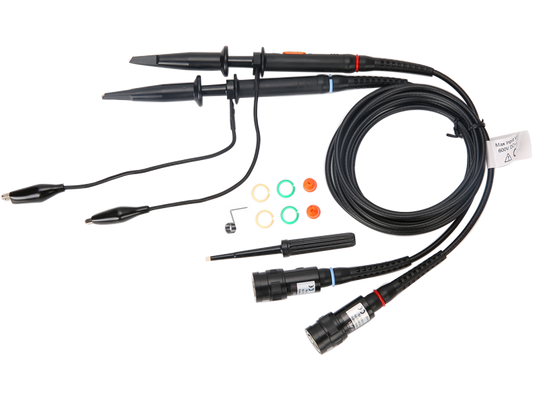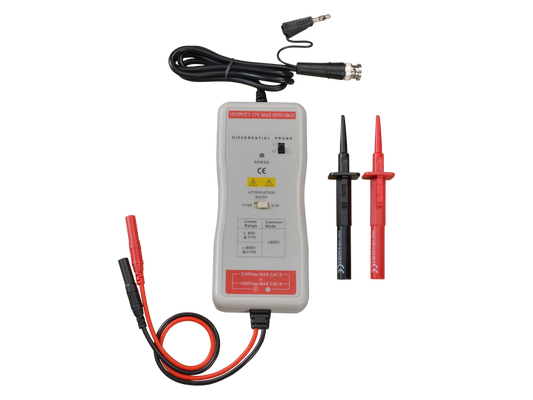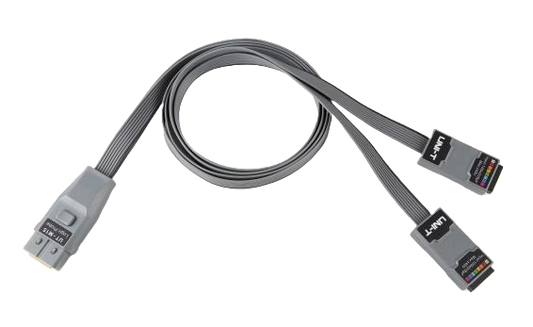UNI-T UT-P4150 | 150A DC-12MHz High-Frequency Current Probe
Overview
The UNI-T UT-P4150 is a professional high-frequency DC/AC active current probe featuring a wide 12MHz bandwidth and exceptional measurement accuracy. Part of the comprehensive UT-P4000 series, this probe excels at capturing both static and dynamic current components with high precision and minimal circuit disturbance. With its impressive 29ns rise time and dual measurement ranges, the UT-P4150 delivers the performance needed by engineers and technicians working with modern power electronics, motor drives, renewable energy systems, and other demanding applications.
Designed for seamless integration with oscilloscopes, this probe transforms your standard high-impedance BNC input oscilloscope into a powerful current measurement system. The UT-P4150 combines precision, durability, and user-friendly operation to help professionals accurately analyze current waveforms across a broad spectrum of applications where understanding both steady-state and transient current behavior is essential to successful design and troubleshooting.
Key Features
-
DC to 12MHz Bandwidth - Captures both static and high-frequency current components
-
Fast 29ns Rise Time - Accurately captures rapid current transitions in switching circuits
-
Dual Measurement Ranges - 150A (0.01V/A) and 30A (0.1V/A) for flexible measurement needs
-
High Measurement Accuracy - ±1% reading ±10mA (30A range), ±1% reading ±100mA (150A range)
-
Degaussing and Auto-Zero Functions - One-touch operation ensures measurement accuracy
-
Over-current Protection - Dual indicators (LED and buzzer) provide clear warnings
-
Wide Conductor Compatibility - Accommodates conductors up to 20mm diameter
-
Universal Oscilloscope Compatibility - Standard BNC interface works with any oscilloscope having high-impedance input
-
Digital Panel Controls - Soft-push keystroke buttons for longer service life
-
Comprehensive Safety Features - Built-in protection against overloads and operational errors
UNI-T UT-P4150 Details
Advanced Current Measurement Technology
The UT-P4150 employs sophisticated Hall Effect technology to provide true DC-to-AC current measurement capabilities. Unlike conventional current transformers that can only measure AC signals, this probe accurately captures the complete current waveform including DC offsets, low-frequency components, and high-frequency transients up to 12MHz. The implementation of advanced signal conditioning ensures minimal insertion loss, preserving circuit integrity while providing highly accurate measurements. With the ability to handle currents from 100mA up to 150A, the UT-P4150 offers the versatility needed for a wide range of applications from sensitive electronic circuits to high-power industrial systems.
Precision Dual-Range Operation
The UT-P4150 features two selectable measurement ranges that optimize performance across diverse testing scenarios. The 30A range provides enhanced resolution with a 0.1V/A transfer ratio, making it ideal for precise analysis of lower-current circuits and devices. For higher power applications, the 150A range with 0.01V/A transfer ratio accommodates substantial current levels while maintaining accuracy. Switching between ranges is accomplished with a simple push of a button, allowing engineers to quickly adapt to different measurement requirements without changing equipment. This flexibility makes the UT-P4150 an exceptionally versatile tool for professionals who work across multiple application domains.
Reliable Measurement Accuracy
Maintaining measurement accuracy is critical for professional applications, and the UT-P4150 incorporates several features to ensure reliable results. The one-touch degaussing and automatic zero setting function removes residual magnetism from the core and establishes a precise zero reference, eliminating drift and ensuring consistent measurements. The probe's sophisticated circuitry provides ±1% accuracy across its operating range, delivering the precision needed for critical power analysis applications. To maintain measurement integrity during extended sessions, the probe should be allowed to warm up for approximately 30 minutes before taking critical measurements, ensuring thermal stability and minimizing offset drift.
User-Focused Design
The UT-P4150 integrates multiple user-friendly features that enhance productivity and measurement reliability. The ergonomic clamp mechanism with opening lever allows for easy connection to conductors up to 20mm in diameter without interrupting the circuit. LED indicators clearly display the selected measurement range and alert users to potential overload conditions. The jaw-on indicator helps ensure the probe is properly closed during measurements, preventing errors from improper connection. Digital controls with soft-push keystrokes provide reliable operation and extended service life compared to mechanical switches. These thoughtful design elements combine to make the UT-P4150 both powerful and practical for daily professional use.
Professional Applications
Power Electronics Development and Testing
The UT-P4150 excels in power electronics applications where accurate current measurement across a wide frequency range is essential. Engineers can analyze switching characteristics of power semiconductors, evaluate converter efficiency, and identify potential issues like shoot-through currents or parasitic oscillations. The probe's fast rise time and DC capability make it particularly valuable for testing and optimizing modern power conversion systems including DC-DC converters, switch-mode power supplies, and inverters. With precise current waveform visualization, designers can fine-tune gate drive circuits, measure switching losses, and ensure reliable operation across varying load conditions, significantly accelerating the development process.
Motor Drive Analysis and Optimization
For motor drive applications, the UT-P4150 provides critical insights into system performance by accurately capturing current waveforms during various operating states. Engineers can analyze startup inrush currents, running waveforms, and fault conditions to optimize controller algorithms and protection mechanisms. The probe's ability to simultaneously measure DC and AC components is particularly valuable when working with brushless DC motors and variable frequency drives where complex current waveforms contain multiple frequency components. The high bandwidth capability allows visualization of PWM switching details, enabling engineers to detect issues with commutation timing, identify bearing problems through current signature analysis, and validate system performance under dynamic loading conditions.
Renewable Energy Systems Testing
The renewable energy sector benefits significantly from the UT-P4150's measurement capabilities during the development and verification of solar inverters, wind power generators, and energy storage systems. Engineers can accurately measure DC bus currents, inverter output waveforms, and battery charging/discharging profiles with a single instrument. The probe's high bandwidth allows detection of high-frequency noise that might affect system efficiency or electromagnetic compatibility. For grid-tied systems, the UT-P4150 helps verify compliance with harmonic content requirements and analyze system response to grid anomalies. Whether measuring the high-frequency ripple current in photovoltaic applications or analyzing the complex current waveforms in multi-level inverters, the UT-P4150 provides the performance needed for comprehensive system characterization.
Semiconductor Device Characterization
Semiconductor development and testing require precise current measurements to characterize device performance under various operating conditions. The UT-P4150's exceptional bandwidth and rise time enable accurate assessment of switching characteristics, on-state behavior, and thermal effects across semiconductor types. Engineers can visualize actual current distribution during switching events, measure conduction losses, and identify potential reliability issues before they impact final designs. This level of insight is especially critical when working with advanced wide-bandgap semiconductors like SiC and GaN where switching speeds continue to increase and measurement precision directly impacts design optimization. The probe's dual range capability allows characterization from initial prototype testing through to full-power validation with a single instrument.
Technical Specifications
| Parameter |
Specification |
| Bandwidth (-3dB) |
DC to 12MHz |
| Rise Time |
≤29ns |
| Current Ranges |
150A (0.01V/A) and 30A (0.1V/A) selectable |
| Continuous Maximum Input |
150Arms (frequency dependent) |
| Maximum Peak Current |
300Apk |
| Measurable Current |
10mA (30A range), 100mA (150A range) |
| Accuracy (DC, 45-66Hz) |
±1% of reading ±10mA (30A range)
±1% of reading ±100mA (150A range) |
| Input Impedance |
See datasheet for frequency curve |
| Delay Time |
36ns (probe) + 5ns (BNC cable) |
| Terminal Load |
≥100kΩ |
| Maximum Conductor Size |
20mm diameter |
| Power Supply |
DC 12V/1A adapter (included) |
| Cable Length |
1.5m |
| BNC Cable Length |
100cm |
| Dimensions (Clamp) |
174 × 67.5 × 30mm |
| Termination Unit |
91.5 × 40 × 26.5mm |
| Weight |
555g |
| Operating Temperature |
0-40°C, ≤80% RH |
| Storage Temperature |
-10-50°C, ≤80% RH |
| Operating Altitude |
≤2000m |
Package Contents
- UT-P4150 Current Probe
- DC 12V/1A Power Adapter
- BNC Connecting Cable (100cm)
- Instruction Manual
- Warranty Card
- Test Report
Frequently Asked Questions
Can the UT-P4150 work with any oscilloscope brand?
Yes, the UT-P4150 features a standard BNC interface that can be used with oscilloscopes from any manufacturer. The probe is powered by its included external adapter, making it independent of oscilloscope power systems. The only requirement is that your oscilloscope must have high-impedance inputs (1MΩ), as the UT-P4150's output is internally terminated. Most modern oscilloscopes meet this requirement, but you should verify that your input is not set to 50Ω when using this probe, as this would result in incorrect measurements.
How accurately can the UT-P4150 measure small currents?
The UT-P4150 can effectively measure small currents, particularly in its 30A range which provides a sensitivity of 0.1V/A. In this range, currents as low as 10mA can be measured with reasonable accuracy. For optimal results when measuring small currents, several best practices should be followed: ensure proper degaussing and zero setting before measurement, avoid changing the probe's position during measurement, and consider using bandwidth limiting on your oscilloscope (typically 20MHz) to reduce noise. For extremely small currents (a few milliamps), you can loop the conductor through the probe multiple times and divide the reading by the number of loops to obtain the actual current value.
What precautions should I take to ensure accurate measurements?
For optimal measurement accuracy with the UT-P4150, follow these key practices: First, allow the probe to warm up for about 30 minutes before taking critical measurements to stabilize internal temperature. Always perform degaussing and zero setting before measurements and ensure no current is flowing during this process. Make sure the jaw is completely closed and locked during measurement, as indicated by the disappearance of the "unlock" indicator. Position the conductor in the center of the sensor aperture, as off-center placement can affect readings. Keep the probe away from strong electromagnetic interference sources like transformers or high-current conductors. For high-frequency measurements, be careful not to exceed the maximum current specified by the frequency-dependent curves in the manual, as this could damage the probe or produce inaccurate results.
How does the degaussing and zero setting function work?
The degaussing and zero setting function is a critical feature that ensures measurement accuracy by addressing two common issues: residual magnetism in the core and output offset voltage. When you press the degaussing/zero button, the probe first applies a demagnetizing waveform to eliminate any residual magnetism that might have accumulated from previous measurements or power cycling. Then, it automatically adjusts the output to establish a precise zero reference point. This process takes approximately 5-6 seconds to complete. During this time, the green indicator light illuminates, and upon successful completion, you'll hear two short beeps. If the process fails, you'll hear a longer one-second beep, indicating you should retry. Always perform degaussing and zero setting with no current flowing through the probe to avoid potential damage to your circuit or inaccurate zeroing.
What are the advantages of the UT-P4150 compared to regular current transformers?
The UT-P4150 offers several significant advantages over conventional current transformers. First and foremost is its ability to measure both DC and AC current components simultaneously, whereas regular current transformers can only measure AC. The UT-P4150's wide frequency range from DC to 12MHz allows it to capture high-frequency transients and harmonics that would be missed by standard current transformers. The non-intrusive clamp design means circuits don't need to be broken to take measurements, improving safety and convenience. The dual measurement ranges (30A and 150A) provide flexibility for different applications with a single instrument. Additionally, the UT-P4150 offers better linearity, lower phase shift, and superior performance with non-sinusoidal waveforms compared to conventional transformers, making it the ideal choice for analyzing modern power electronics systems with complex waveforms.
What safety precautions should I observe when using the UT-P4150?
When using the UT-P4150, several important safety precautions must be observed: Never attach the clamp to circuits that operate above the maximum rated voltage to earth (600V CATII, 300V CATIII). Avoid clamping around bare conductors; always measure insulated conductors to prevent electrical shock. Never touch the clamp in front of the barrier or the conductor being measured while taking measurements. Ensure your oscilloscope is properly grounded and features double-insulation construction. Don't use the probe in wet conditions or with wet hands. Take special care when working with high voltages or currents, and follow all standard electrical safety protocols. The probe contains sensitive components that can be damaged by excessive heat, mechanical shock, or sudden temperature changes, so handle it with appropriate care. Always observe the maximum current limitations, particularly at higher frequencies, as exceeding these limits can damage both the probe and potentially the circuit under test.
Customer Testimonials
"As a power electronics engineer developing GaN-based switching converters, the UT-P4150's bandwidth and fast rise time have been essential for visualizing the high-speed switching transients in our designs. The ability to see both DC levels and high-frequency components simultaneously has helped us optimize gate driver circuits and reduce switching losses significantly. The dual range capability means we can use one probe from initial low-power prototype testing through to full-power validation." - Wei L., Senior Power Electronics Engineer
"In our electric vehicle testing facility, we rely on the UT-P4150 for analyzing motor drive currents and battery management systems. The probe's accuracy and wide bandwidth let us capture everything from DC battery currents to high-frequency inverter switching characteristics. The durable construction has withstood daily use in our industrial environment, and the degaussing feature ensures consistent measurements throughout long test sessions." - Rajiv S., Automotive Systems Test Manager
"Our solar inverter development team depends on the UT-P4150 for validating both DC input stages and AC output performance. The ability to measure from DC to high frequencies with a single instrument has streamlined our workflow considerably. When we encountered unexpected harmonics in a new design, the UT-P4150's excellent frequency response helped us quickly identify and resolve issues that our previous equipment couldn't even detect." - Maria G., Renewable Energy Systems Engineer
Warranty and Support
The UNI-T UT-P4150 High-Frequency Current Probe comes with a comprehensive 1-year warranty covering manufacturing defects under normal use conditions. UNI-T provides dedicated technical support through our experienced engineering team, with responsive service available via phone, email, and our online knowledge base. For maximum reliability, we recommend annual calibration to ensure continued measurement accuracy. If you encounter any issues with your probe, please contact your local UNI-T representative or authorized distributor rather than attempting repairs yourself, as disassembly of the probe will void the warranty.
Professional Current Measurement for Advanced Applications
The UNI-T UT-P4150 High-Frequency Current Probe combines exceptional bandwidth, measurement accuracy, and ease of use in a professional-grade instrument. From power electronics development to motor drive analysis, semiconductor testing to renewable energy systems, this versatile probe provides the measurement insights necessary for successful design, optimization, and troubleshooting. Experience the difference that comprehensive current waveform analysis can make in your next project with the UT-P4150's precise, reliable performance.



